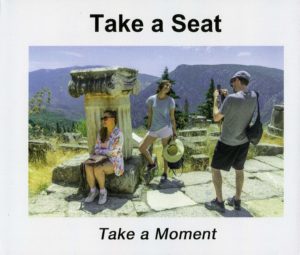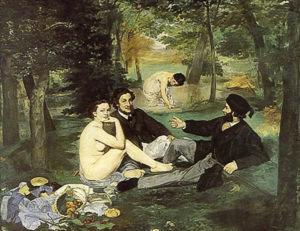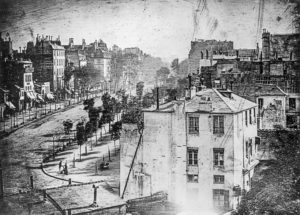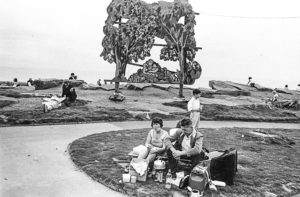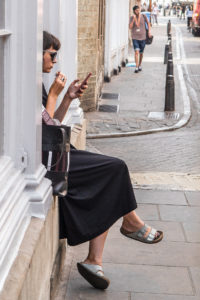I’ve posted pictures and text from my Take a Seat project frequently since March 2019. Enforced lockdown leisure has given me time to bring them together in a book. An introduction outlines of what I was trying to achieve and gives an overview of the pictures (both reproduced in full here). I have included some historical context showing how the seated figure has been treated in painting and photography (summarised here).
Introduction
When I get home after a long drive the first thing I want to do is sit down. I have often thought that if I were to be cast away on Roy Plomley’s mythical desert island my luxury would be a comfortable armchair (with built-in espresso machine). Being bipedal animals confers many advantages on us, but we still invite guests to, ‘Take the weight off your feet’. Sitting comfortably is a pleasure. Passively, it encourages, relaxation, contemplation and may allow us to be in the moment. Often it lulls us into recumbent sleep. Actively, we can forget about the weight on our feet and concentrate on reading, writing, work and more. Sitting is the posture for sharing food, laughter and confidences.
We sit at home – on a luxury recliner, a stool, a mat. And we sit outside in public and semi-public spaces – on benches, on walls, in trains, on the ground, at café tables. We relax, and abandon the hither and thither of busy lives to take a seat, take a moment, to retreat into our own world or share in the pleasure of others.
My photographs explore the diverse experiences of being still outside. Take a Seat complements my earlier book, Ruckenfigur Revisited (2013). Photo books that focus on small areas of human activity are an engaging way of using the medium, for example Elliott Erwitt’s Handbook (2003), Andre Kertesz’s On Reading (2008), People Kissing by Levine and Ramey (2019) and Screen Time by Dafydd Jones (2019).
I have tried to provide a context for my pictures by looking at how painting and photography have depicted the natural seated or recumbent figure historically. Across all media, the figure may be active or passive; it may be solitary or in groups of two or more. It may be part of a scene reflecting or taken from real life; or it may be pure imagination.
Seated Figures in Painting and Photography
The depiction of seated figures dates back to pre-historic cave paintings. Portraiture, developed during the Middle Ages to honour the rich and powerful; and in Romanesque art human figures were depicted mainly as sanctified subjects. Everyday figures began to appear from 1350. In Renaissance art religious subjects were dominated by seated Madonnas, while classical subjects showed the gods reclining in idyllic settings. There was a demand for secular subjects in the late 16th century. This included a growth in genre painting which featured people going about their business, including sitting as they worked, rested or socialised. Throughout the periods of Neoclassicism and Romanticism in art non-portrait seated figures appear incidentally. Nineteenth century Realist art showed people of all social classes, putting them in real situations. The birth of Modern art is often dated to 1863, when Édouard Manet showed Le déjeuner sur l’herbe, the archetypal ‘take a seat’ painting, in the Salon des Refusés in Paris. Edgar Degas was inspired by the beauty of the transient moments of repose found in everyday life in the streets. Figures sitting outside occur in the work of many other Impressionists. New art movements, such as Social Realism drew attention to working class living conditions; in the United States it depicted quiet moments in semi-public and public spaces.
The informal seated figure appears in many guises throughout western painting, from praying to giving blessings, smoking to cooking, bathing to writing and seducing to playing cards. There are groups of people interacting; individuals resting, relaxing, thinking; people reading; individuals or groups eating; musicians performing; people contemplating a view; and artists painting. The mix changed over time, change that was reinforced by the advent of photography, which freed painting from the demands for formal portraiture.
The View of the Boulevard du Temple, a daguerreotype made by Louis Daguerre in 1838, is generally accepted as the earliest photograph to include people. Echoing the painter’s fascination with the human form portraits soon followed – Robert Cornelius created a self-portrait in 1839. Charles Nègre was the first photographer with the technical skills to register people in movement on the street, his work included seated figures, such as The Little Ragpicker, 1851. In the 19th Century the documentary work of John Thomson and Paul Martin included seated figures. At the end of the century the Linked Ring and the Photo Secession promoted salon photography as a fine art and the practitioners used seated figures in their careful compositions At the same time Kodak’s democratisation of the medium meant people sitting, sleeping, eating, reading and sunbathing were now captured for the family album.
The introduction of lighter cameras, high quality lenses and faster film revolutionised photojournalism and documentary photography in the 1920 and 30s, allowing photographers like Andre Kertesz, Henri Cartier-Bresson and Humphrey Spender, to capture fleeting moments in public as part of their witness to the world. In the United States the Farm Security Administration recorded farming life to help in the battle against rural poverty during the Great Depression. All revealed sitting outside as part of the human condition. Post war humanist photographers, such as the founders of Magnum, sought their subjects in public realms. Robert Frank’s The Americans (1968), captured a cold eyed, subjective, view of society – he shows people physically at rest, but they do not look at ease. Seated figures are occasional islands of calm in the restlessness that pervades the photography of Garry Winogrand, Lee Friedlander and Joel Meyerowitz. In the UK Tony Ray-Jones turned an ironic eye on people at leisure unaware of their surreal absurdity. Martin Parr’s eye is more acerbic, casting seated figures as a part of the litter and clutter of public spaces.
With a few 19th century exceptions, photography ignores iconic religious, historical and academic constructions. Yet photography owes a debt to painting: its concerns were a logical development of the earlier genre schools and for a while it proceeded in parallel with those artist who were painting modern life.
Overview
The 110 photographs included here show seated figures in streets, cafes, parks and galleries, by the sea and in a dozen other places. Taking advantage of chairs, benches, walls, bicycles and the ground, they squat, perch, sit, lounge and sleep. They talk, they read, they eat and drink, they stare at their phones, they simply sit and relax, and they do a score of other things. Sometimes they just watch and wait, but are rarely merely loitering.
There are groups of sitters, centres of togetherness, of sharing. What are their relationships with each other? Some people sit alone, holding the world at bay with books, phones or laptops and headphones. Detached from people and place, are they lonely or enjoying quiet concentration? Some sitters share the moment with a dog.
And many share their emotions, their mental state, with the world. Happiness, elation, concentration, detachment, tiredness, ennui and boredom are written on the faces and in the body language. Relaxation and concentration alike lower the natural defences and the subjects share their emotions involuntarily. And being caught unawares they seldom look their best when eating or sleeping.
Seated individuals and groups are the subjects of these pictures, yet they tell us more. We see the environment in which they sit, from café to seaside, train to gallery and we know the weather they are enjoying. There are contrasts and unexpected juxtapositions within and between pictures that suggest hidden stories. The seated figure may set the context for something else, a child playing or a passing parade perhaps.
Each picture is a historical record of fashions, trends and preoccupations. We see all that figures at rest offer across classes, ages and genders. Looking back to painting and early photography we see many of the same behaviours recurring. There is one big difference, the impact of information technology: mobile phones are an endless distraction; and tablets and laptops liberate (or ensnare) people to work anywhere when they take a seat. They are a pervasive facet of the 21st Century world. One hundred and sixty years on they are what Charles Baudelaire would see as exemplars of modern life and present-day beauty. They look further back too: in the age of the image the figure cradling a smart phone is a 21st century Madonna and Child.

